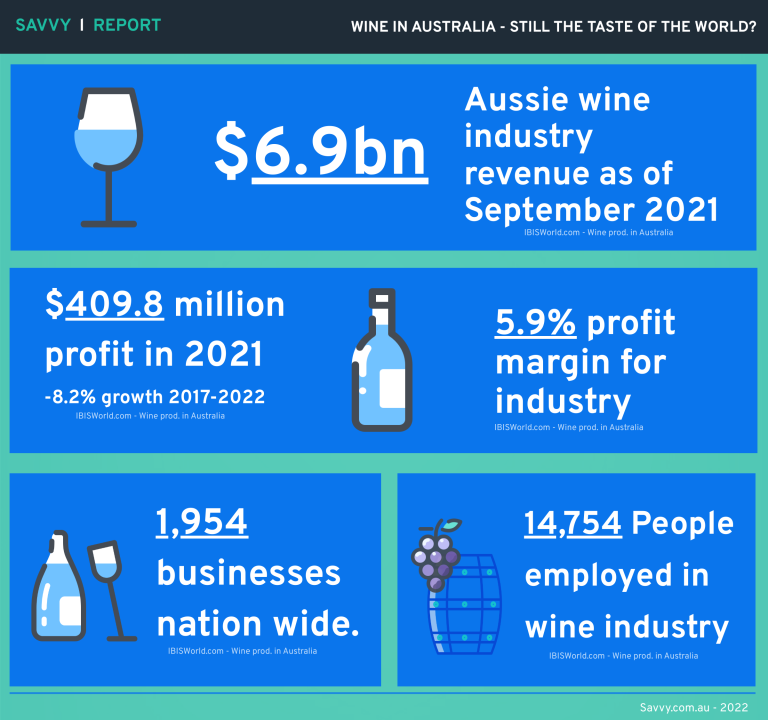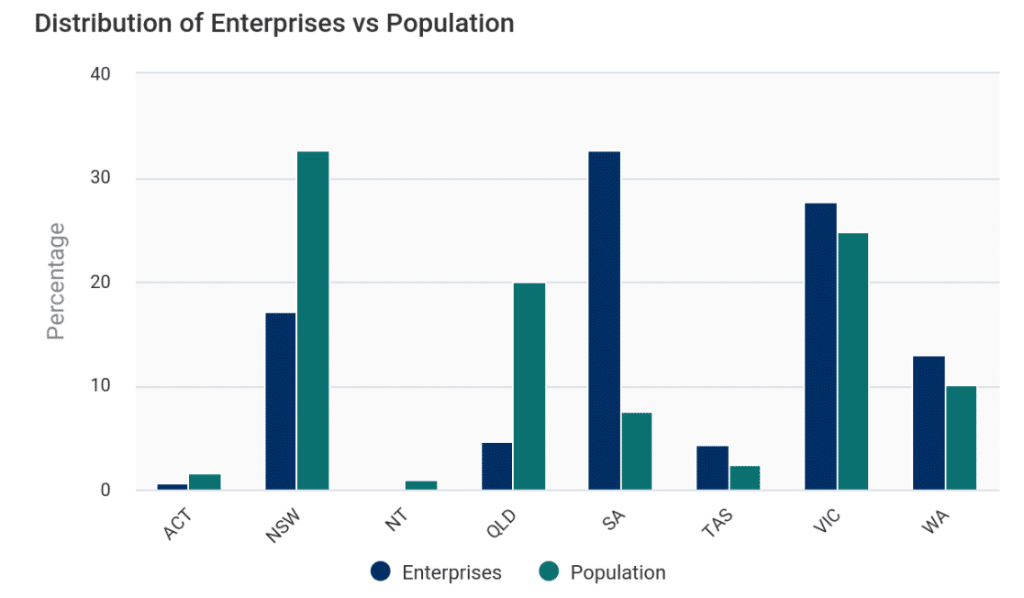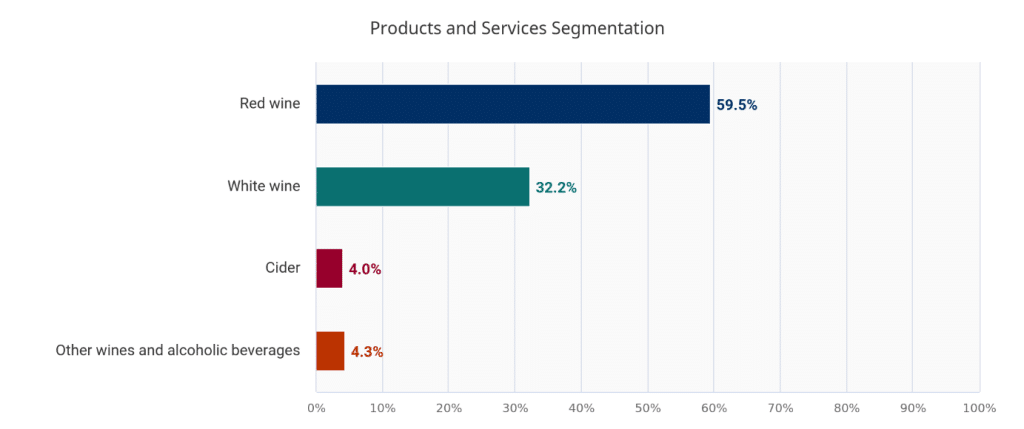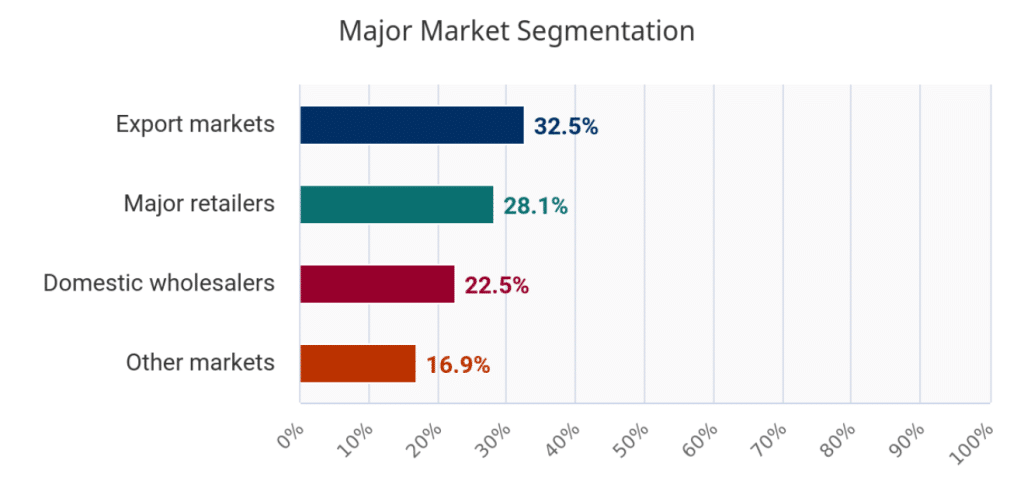
- The Savvy Promise
At Savvy, our mission is to empower you to make informed financial choices. While we maintain stringent editorial standards, this article may include mentions of products offered by our partners. Here’s how we generate income.
In this article
In the last several years the Australian wine industry has faced significant negative impacts from the pandemic, freight disruptions and international tariffs on exports. Despite this, annual revenue growth projections for the 2022-2027 period are positive. Savvy’s report performs a deep dive into the latest figures to shed light on the current state of the wine industry in Australia.
- $6.9 billion in revenue as of September 2021
- $409.8 million profit in 2021
- -8.2% profit growth 2017-2022
- 2.5% projected revenue growth for 2022-2027
- 14,754 people employed in wine industry
- Trend towards higher premium wine output has supported industry
The great novelist Ernest Hemingway once wrote that “wine is the most civilised thing in the world” and it’s no wonder that almost every nation on Earth makes wine – and drinks it. Australian wine is considered among some of the best in the world. The size of the industry certainly underpins that fact, taking in A$6.9 billion in revenue as of September 2021.
However, during the COVID-19 pandemic and other internationally led factors, growth and profits from the Australian wine industry dipped. This can be explained by tariffs imposed by our largest export destination, China, as well as consumption habits and government restrictions. So, is Australian wine still the taste of the world? Do we drink as much wine as we export? Where are all the wineries in Australia? Which sector of the industry profits most? What will happen to Australian wine in the future? We answer all that and more in our comprehensive overview of the Australian wine industry in 2022.
Size of the Industry
According to IBISWorld, the Australian wine industry is worth $6.9 billion, taking in $409.8 million in profits as of the final quarter of 2021. This represents a 5.9% profit margin for producers and wineries. In terms of how wine impacts the broader Australian economy, the wine industry generated $1.1b in wages, spread out across 14,754 employees and 1,954 businesses. The overall annual profit growth of the market has been negative however at -8.2% between 2017-2022.
Annualised growth in terms of revenue over 2017-2022 showed a dip of 0.6%, while projections show annual growth over 2022-2027 to increase by 2.5%.
There is no far-and-away dominant winery or wine producer in Australia – minor players comprise almost two-thirds share of market revenue (65.7%) with the top wineries in Australia being Treasury Wine Estates (13.5%), Accolade Wines, Casella Family Brands (7.7%) and Pernod Ricard Australia (7%.)

Alcohol Consumption in Australia
The method of Alcohol consumption in Australia was turned upside down during the COVID-19 pandemic – due to the extended shutdown of pubs, clubs, and other venues where alcohol was served.
However, the volume of consumption stagnated. According to the Foundation for Alcohol Research and Education, the same proportion of people drank more or less than previously (17%). 38% of people self-reported that their consumption stayed the same. This also hews with the IBIS report, showing per-capita alcohol consumption staying the same over 2017-2022.
The ABS reports that pure alcohol consumption in wine per capita narrowed the gap between beer as of 2017-18, with 3.67L of alcohol in wine consumed vs 3.71L in beer. The widest gap was last seen in 1973-74, with 2.05L of wine consumed per capita versus a whopping 9.18L of beer.
Wineries and Wine Regions in Australia
Australia has over 60 designated wine regions, with most of them clustered in Victoria (20), followed by South Australia (18), NSW (16-18, depending on division of sub-regions) WA (15, again depending on how regions are subdivided). Victoria arguably has the greatest area suitable to wine making, as a portion of its land area, due to its cool climes. Meanwhile South Australia, famous for its distinctive reds and rich and fertile south-east, is home to such renowned regions as the Barossa Valley, McLaren Vale and the Coonawarra, to name a few. SA and Victoria have the best climates for wine production in Australia, considered a “Mediterranean” analogue.

Supply Chain of Wine
The key sellers of wine production are grape growers, fruit and vegetable processors, flour and grain manufacturing, paperboard makers, and glass and glass product manufacturing. These comprise the ingredients and packaging for wines. Other considerations for wine making include nursery production, livestock, and agricultural supplies to ensure healthy grape growth, and chemical product wholesaling.
Wine gets to us through large liquor wholesalers – while the second tier is comprised of direct-to-consumer retail sales such as casinos, hotels, retailers, and hospitality venues.
Red vs White Wine
Red wine production leads the way in the Australian wine industry, comprising 59.5% of all products, followed by white wine on 32.2%. Cider accounts for 4% of production, and other wines and alcoholic beverages on 4.3%.

Source: IBISWorld.com, Wine Production in Australia, p.21
Who In Australia Drinks Wine?
According to IBISWorld, people with higher disposable income usually drink wine, as it’s considered a premium, non-essential product. Wine demand has also increased, particularly white wine among young female drinkers. Wine consumption is also moderated by health concerns: wine is often used as a digestive or sleeping aid by some people; beer and ‘hard’ liquors are often seen as unhealthy.
Though we produce a lot of wine ourselves, we imported $928.2 million worth of wine from around the world. According to Wine Australia, of the 95 million litres imported per year, which makes up only 20% of domestic consumption, two thirds comes from New Zealand. IBISWorld's report however identifies the United Kingdom as a significant source (22.9%) Other countries importing wine to Australia include France, Italy, Spain, the USA and select South American nations.
Who in the World Drinks Wine?
According to Wine Australia in the year ended December 2021, Australian exporters shipped wine to 112 markets, compared with 114 the year before. IBISWorld reported that exports amounted to $2.3 billion. Export markets account for 32.5% of market share of Australian wine by revenue in 2021-22. By comparison, Wine Australia states that Australia exports 59% of all wine produced.
The top three markets by value were the United Kingdom ($453 million, down 1%), the United States ($403 million, down 7%), and Hong Kong SAR ($192 million, up 45%).
The top three markets by volume were also the United Kingdom, buying 243 million litres; the United States 125 million litres; and Canada 47 million litres.
Nations participating in the Trans-Pacific Partnership (signed in 2018) will also increase opportunities as tariffs are gradually reduced over time.
China Wine Embargo – What happened to Australian Wine exports?
Since 2016, China has been the largest export market for Australian wines. However, due to political manoeuvring and disagreements, China began a campaign of scaling back Australian trade on key goods such as coal, barley, meat, and of course, wine.
In December 2020, the Chinese Government imposed “anti-dumping” sanctions on Australian wine, amounting to tariffs in excess of 100% – in some cases, double that number. This left wine producers scrambling to find new buyers for approximately $1.26 billion worth of wine.
According to a statement by Wine Australia, “exports to mainland China declined by 97 per cent in value to $29 million and by 93 per cent in volume to 6.4 million litres, a loss of nearly $1 billion in value and 90 million litres in volume, when compared to the 2020 calendar year where shipments were free from tariffs for most of the year.”
Though a total of 63 million litres were shipped in December 2021 – the largest month for exports since the big slump in October 2020 – was still the lowest volume shipped within a 12-month period since the year ended September 2004.
Further complications arose during 2020-21 due to the global supply chain crisis, where sea shipping costs rose over 150% over previous years.

Source: IBISWorld.com, Wine Production in Australia, p.25
Who profits most from wine sales in Australia?
The major market segmentation for wine is major retailers such as Coles or Woolworths (28.1%), domestic wholesalers (22.5%) and other markets (16.9%).
Market concentration in Australian wine is low, with the four major Australian wine producers taking up a 34.3% share of industry revenue in 2021-22.
The four major producers are Treasury Wine Estates Ltd. with a market share of 13.5%. They produce some of Australia’s most premium brands including Penfolds, Wolf Blass, Lindeman’s, and Rosemount Estate.
Accolade Wines was in second position in terms of 2020 total wine production, according to Wine Titles.
Casella Wines Pty. Ltd., in third position as of 2020 in terms of total wine production, shares 7.7% of the market and makes wines such as Yellow Tail and Casella 1919. Yellow Tail has performed well in the United States due to its unique and aggressive “Blue Ocean” strategy of marketing.
Pernod Ricard Pacific Holdings has a 7% market share and is the subsidiary of French luxury spirits and wine group Pernod Ricard SA. They own the respected brands of Jacob's Creek, I am George, and St Hugo.
Underneath the “Big 4” are medium-sized wine companies including Australian Vintage Limited (4% share), Kingston Wine Estates and De Bortoli Wines. A dozen or so smaller producers also contribute to total production, adding variety to the market.
According to Bill Tsouvalas, finance expert and founder of Savvy,
“While the fundamentals of the wine business remain good, the industry has really been impacted by first the China trade tariffs and now the ongoing pandemic. This has been reflected in the decline in business equipment lending we've seen in that sector, compared say to the craft beer market, where producers are increasing in number and expanding production capacity.
This may have as much to do with the comparative maturity of the industry - Australian wine producers have been established much longer and probably now have excess production capacity."
The future of Australian Wine Production
Wine production is considered part of the Traditional Service Economy – combining labour and goods to create products for consumption. Wine production is exposed to threats by disruptive innovation – the cost of entering the market may be lowered by investment in new innovations and the rate of innovation. However, smaller players are unlikely to unseat the “Big 4” wine producers as the wine industry is a highly concentrated market. Wine has only seen moderate revenue volatility over the past five years – mostly due to unforeseen geopolitical circumstances. The Wine production industry also receives moderate industry assistance to increase Australian competitiveness and a wine equalisation tax introduced in 2000 to support smaller wineries in Australia.
Industry data shows that revenue will increase year on year until 2027, with 2023 showing an increase of $279 million. With a global and local taste for wine, Australian wine production has its best years ahead.
For more information, contact Adrian Edlington – [email protected]
Reeves, M. Wine Production in Australia – Cellar Turmoil: Exports are set to decline in the current year due to the COVID-19 outbreak, AU INDUSTRY (ANZSIC) REPORT C1214: IBISWorld, Australia. September 2021.
WineAustralia.com - Wine Australia Export Report - December 2021
WineAustralia.com - Labelling - Register of Protected GIS and Other Terms - Geographical Indications
WineAustralia.com - Regions and Varieties
WineAustralia.com - Market Insights - Australia Domestic
WineTitles.com.au - Australia's Largest Wine Companies by Total Wine Production
FARE.org.au - Alcohol Use and Harm During COVID-19
ABS.gov.au - Apparent Consumption Alcohol Australia - Latest Release
ABC.net.au - Australian Trade Tension Sanctions China Growing Commodities
FreightAustralia.gov.au - Annual Report - Sea Freight
TheStrategyStory.com - The Blue Ocean Strategy Behind Yellow Tail
Did you find this page helpful?
Author
Adrian EdlingtonGuest Contributor
Bill TsouvalasPublished on March 10th, 2022
Last updated on March 18th, 2024
Fact checked
This guide provides general information and does not consider your individual needs, finances or objectives. We do not make any recommendation or suggestion about which product is best for you based on your specific situation and we do not compare all companies in the market, or all products offered by all companies. It’s always important to consider whether professional financial, legal or taxation advice is appropriate for you before choosing or purchasing a financial product.
The content on our website is produced by experts in the field of finance and reviewed as part of our editorial guidelines. We endeavour to keep all information across our site updated with accurate information.











